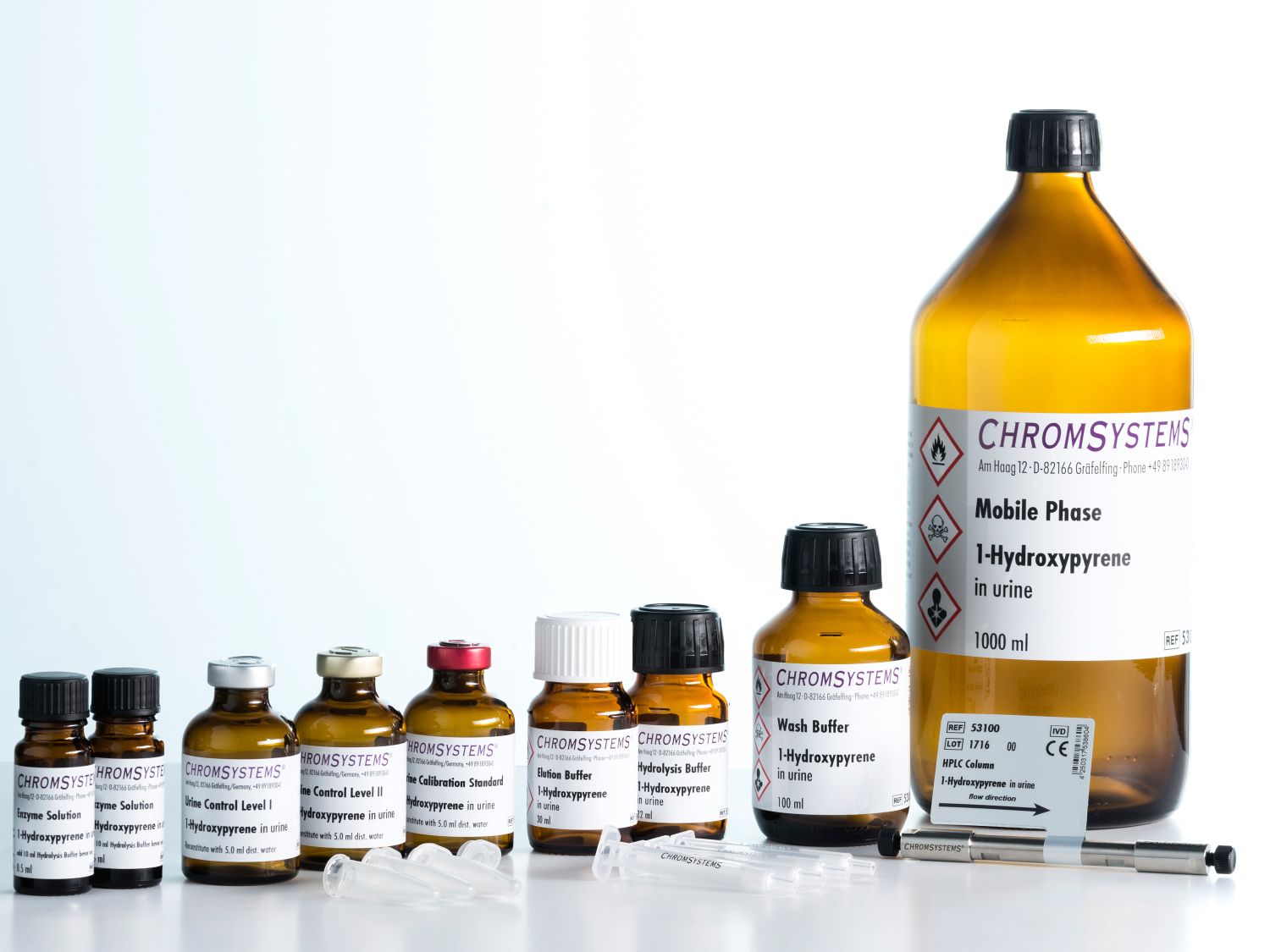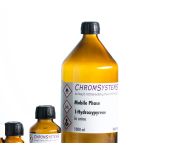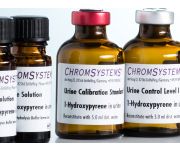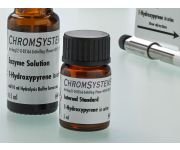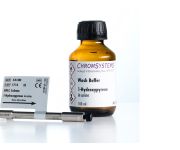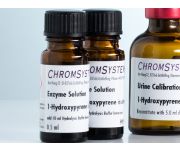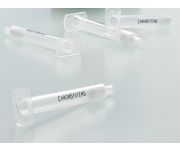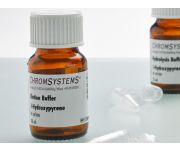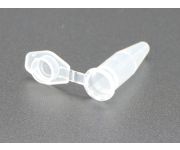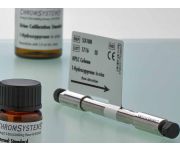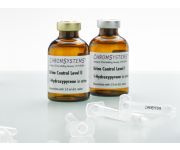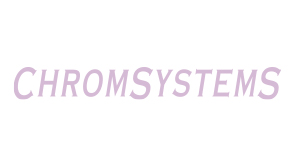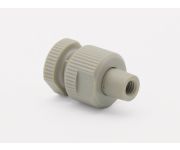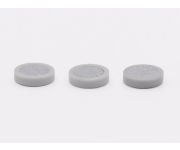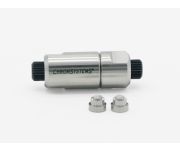1-Hydroxypyrene in Urine - HPLC
Complete CE-IVD kit, including internal standard and mobile phase
Effective hydrolysis in only 2 hours – with integrated colour indicator for pH adjustment
Analysis time of less than 7 minutes
CE-IVD validated product ready for IVDR within timeframes and transition periods specified by the IVDR 2017/746
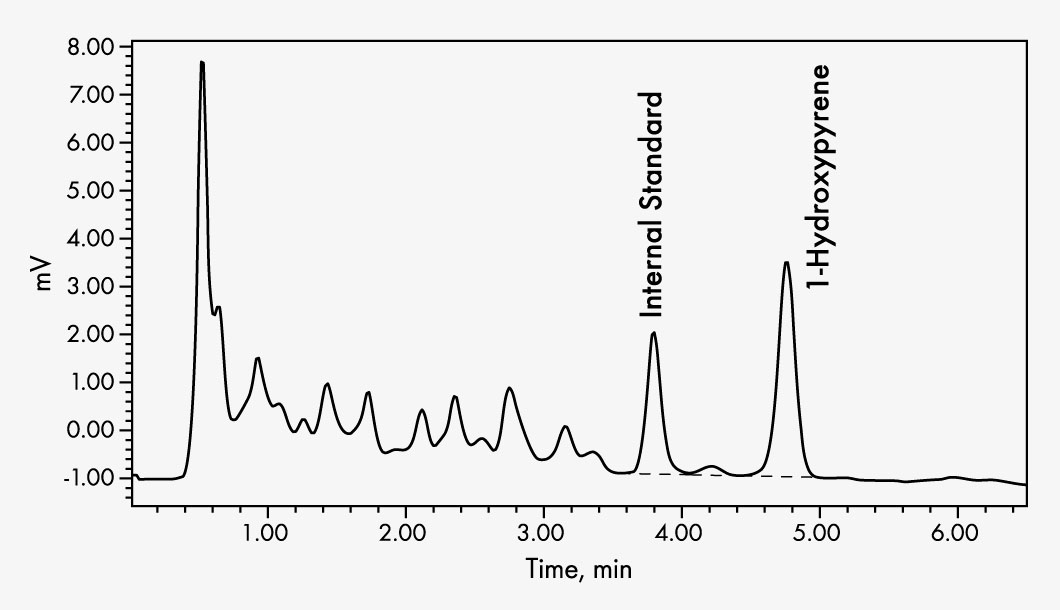

1-Hydroxypyrene
Clinical relevance
Polycyclic aromatic hydrocarbons (PAHs) are hydrocarbons composed of multiple aromatic rings with potential carcinogenic properties. Physiological monitoring of these substances is therefore essential in occupational health and in particular in industries where workers are potentially exposed to high levels of PAHs, such as in aluminium, iron and steel manufacturing. One of the parent PAHs is pyrene, which undergoes a simple metabolism to 1-hydroxypyrene. 1-Hydroxypyrene and its glucuronide are excreted in urine, making it suitable for monitoring. Pyrene is always present in PAH mixtures and is therefore not only an indicator of pyrene accumulation, but also of an overall exposure to PAHs.
Product advantages
- Complete CE-IVD kit, including internal standard and mobile phase
- Effective hydrolysis in only 2 hours – with integrated colour indicator for pH adjustment
- Analysis time of less than 7 minutes
- Equilibrated, tested and ready to use HPLC column
- Simple isocratic HPLC system sufficient
This Chromsystems assay enables the reliable determination of 1‑hydroxypyrene from urine using an isocratic HPLC run within 7 minutes. The sample preparation is fast and simple and requires only two steps: 1-hydroxypyrene is de-conjugated by an efficient and fast enzymatic hydrolysis, followed by solid phase extraction using Sample Clean Up Columns. The correct pH required for precise analysis is visually verified by a colour changing indicator. The inclusion of an internal standard ensures reproducible and reliable quantitative results. 1-Hydroxypyrene is measured using optimised chromatographic separation with highly sensitive fluorescence detection, ensuring elimination of most potential interferences. The human-matrix based calibration standard and controls ensure precision and accuracy of results.
| Method of Analysis | HPLC |
|---|---|
| Number of Tests | 100 |
| Please note | The freely available information on this website, in particular on the sample preparation, are not sufficient to work with our products. Please read instructions and warning notices on products and/or instruction manuals. |
| Lower Limit of Quantitation | 0.1 µg/l |
| Upper Limit of Quantification | up to 20 µg/l |
| Intraassay | CV = 0.9–2.7 % |
| Interassay | CV = 2.7–5.7 % |
| Recovery | 92 % |
| Reference ranges | For non-smokers aged 3 to 69 years, the following reference value applies: 1-Hydroxypyrene: 0.5 µg/l (0.3 µg/g creatinine) Reference value, also known as Biological Reference Value (BRV) = 95th percentile of frequency distribution of urinary 1-hydroxypyrene concentration in the non-occupationally exposed population |
| Specimen | Urine |
| Sample Preparation | ENZYMATIC HYDROLYSIS
SOLID PHASE EXTRACTION
|
| Run Time | 6.5 min |
| Injection Volume | 10 µl |
| Flow Rate | 1.2 ml/min |
| Column Temperature | 35 °C |
| Wavelengths | EX 242 nm |
| Additional Info | Any isocratic system with fluorescence detector is suitable. |
| Parameters | 1-Hydroxypyrene |


1-Hydroxypyrene
Clinical relevance
Polycyclic aromatic hydrocarbons (PAHs) are hydrocarbons composed of multiple aromatic rings with potential carcinogenic properties. Physiological monitoring of these substances is therefore essential in occupational health and in particular in industries where workers are potentially exposed to high levels of PAHs, such as in aluminium, iron and steel manufacturing. One of the parent PAHs is pyrene, which undergoes a simple metabolism to 1-hydroxypyrene. 1-Hydroxypyrene and its glucuronide are excreted in urine, making it suitable for monitoring. Pyrene is always present in PAH mixtures and is therefore not only an indicator of pyrene accumulation, but also of an overall exposure to PAHs.
Product advantages
- Complete CE-IVD kit, including internal standard and mobile phase
- Effective hydrolysis in only 2 hours – with integrated colour indicator for pH adjustment
- Analysis time of less than 7 minutes
- Equilibrated, tested and ready to use HPLC column
- Simple isocratic HPLC system sufficient
This Chromsystems assay enables the reliable determination of 1‑hydroxypyrene from urine using an isocratic HPLC run within 7 minutes. The sample preparation is fast and simple and requires only two steps: 1-hydroxypyrene is de-conjugated by an efficient and fast enzymatic hydrolysis, followed by solid phase extraction using Sample Clean Up Columns. The correct pH required for precise analysis is visually verified by a colour changing indicator. The inclusion of an internal standard ensures reproducible and reliable quantitative results. 1-Hydroxypyrene is measured using optimised chromatographic separation with highly sensitive fluorescence detection, ensuring elimination of most potential interferences. The human-matrix based calibration standard and controls ensure precision and accuracy of results.
| Method of Analysis | HPLC |
|---|---|
| Number of Tests | 100 |
| Please note | The freely available information on this website, in particular on the sample preparation, are not sufficient to work with our products. Please read instructions and warning notices on products and/or instruction manuals. |
| Lower Limit of Quantitation | 0.1 µg/l |
| Upper Limit of Quantification | up to 20 µg/l |
| Intraassay | CV = 0.9–2.7 % |
| Interassay | CV = 2.7–5.7 % |
| Recovery | 92 % |
| Reference ranges | For non-smokers aged 3 to 69 years, the following reference value applies: 1-Hydroxypyrene: 0.5 µg/l (0.3 µg/g creatinine) Reference value, also known as Biological Reference Value (BRV) = 95th percentile of frequency distribution of urinary 1-hydroxypyrene concentration in the non-occupationally exposed population |
| Specimen | Urine |
| Sample Preparation | ENZYMATIC HYDROLYSIS
SOLID PHASE EXTRACTION
|
| Run Time | 6.5 min |
| Injection Volume | 10 µl |
| Flow Rate | 1.2 ml/min |
| Column Temperature | 35 °C |
| Wavelengths | EX 242 nm |
| Additional Info | Any isocratic system with fluorescence detector is suitable. |
| Parameters | 1-Hydroxypyrene |

